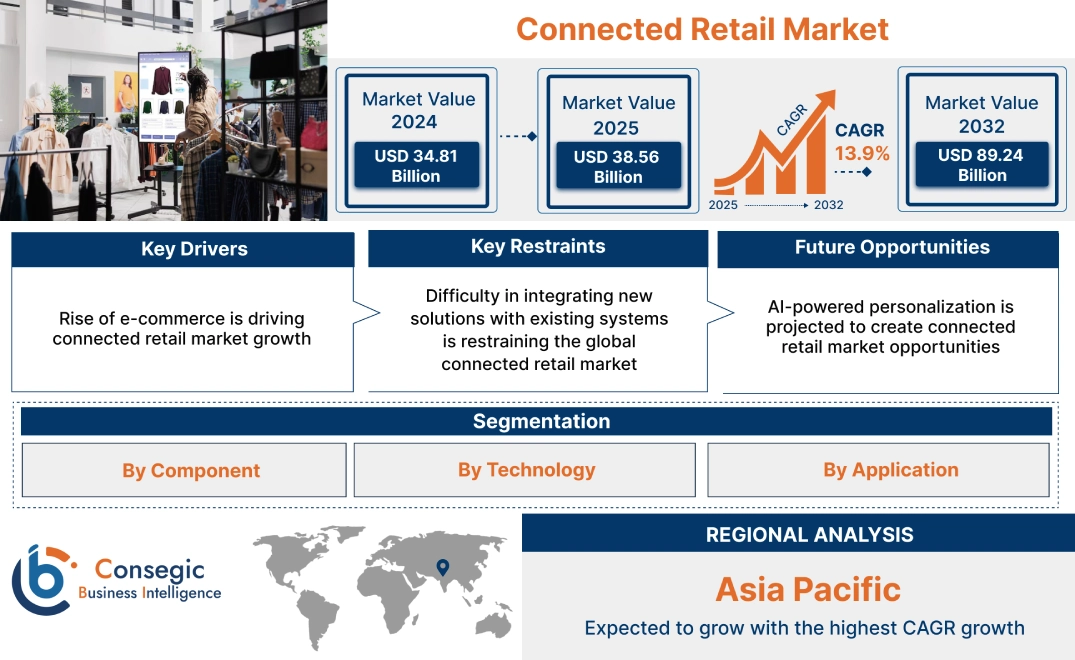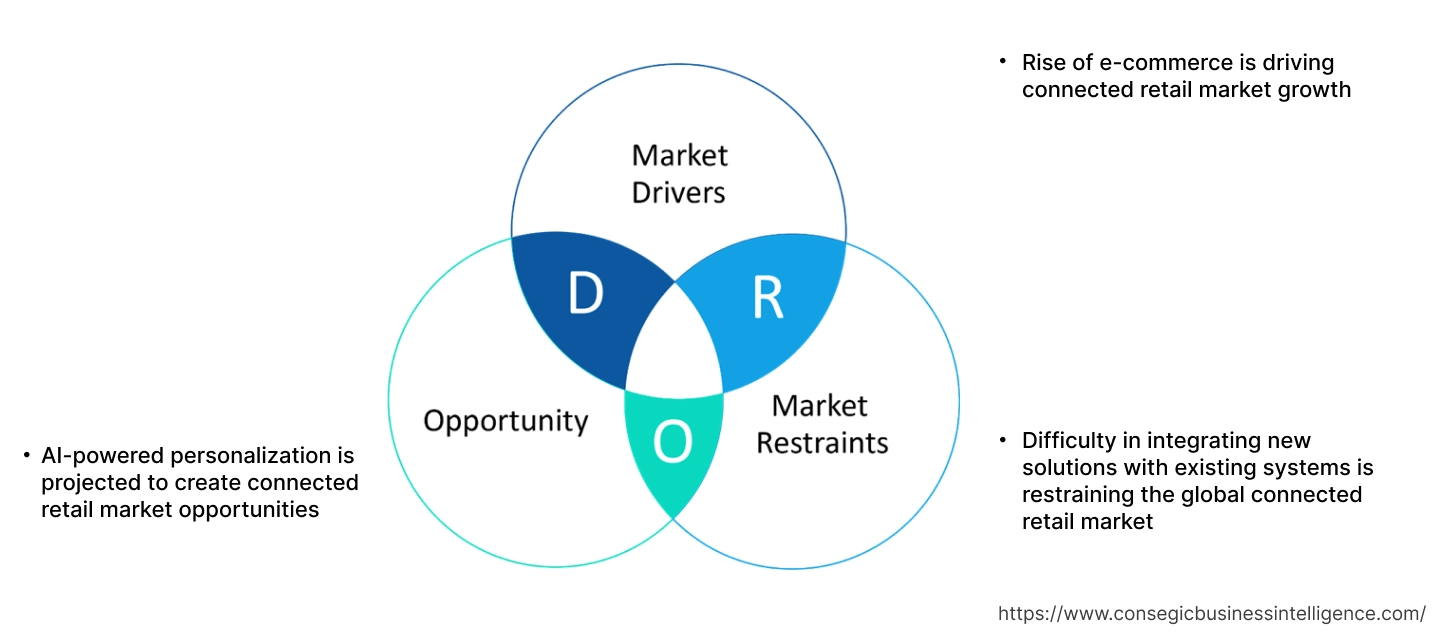- Summary
- Table Of Content
- Methodology
Connected Retail Market Size:
Connected Retail Market Size is estimated to reach over USD 89.24 Billion by 2032 from a value of USD 34.81 Billion in 2024 and is projected to grow by USD 38.56 Billion in 2025, growing at a CAGR of 13.9% from 2025 to 2032.
Connected Retail Market Scope & Overview:
Connected retail refers to the integration of digital technologies into the traditional retail experience, creating a seamless shopping journey for customers across online and offline channels. The approach aims to break down the barriers between physical stores and e-commerce, allowing retailers to provide personalized experiences, real-time inventory information, and flexible fulfillment options.
Key Drivers:
Rise of e-commerce is driving connected retail market growth
Connected retail solutions are essential for traditional retailers to meet the heightened consumer expectations set by e-commerce. These expectations include seamless, personalized experiences, online product browsing, in-store availability checks, and multiple fulfillment options. Additionally, the convergence of online and offline shopping, driven by e-commerce, necessitates a seamless, unified customer experience. Connected retail solutions are vital for integrating data across channels, enabling retailers to deliver personalized recommendations, targeted promotions, and consistent service, hence boosting the connected retail market trend.
- For instance, according to International Trade Administration, the global B2B e-commerce market is experiencing significant growth, with projections indicating it will reach USD 36 trillion by 2026. This surge is driven largely by heavy industries like advanced manufacturing, energy, healthcare, and professional business services, which are increasingly shifting their sales online.
Consequently, the growth of the e-commerce industry is driving the connected retail market expansion.
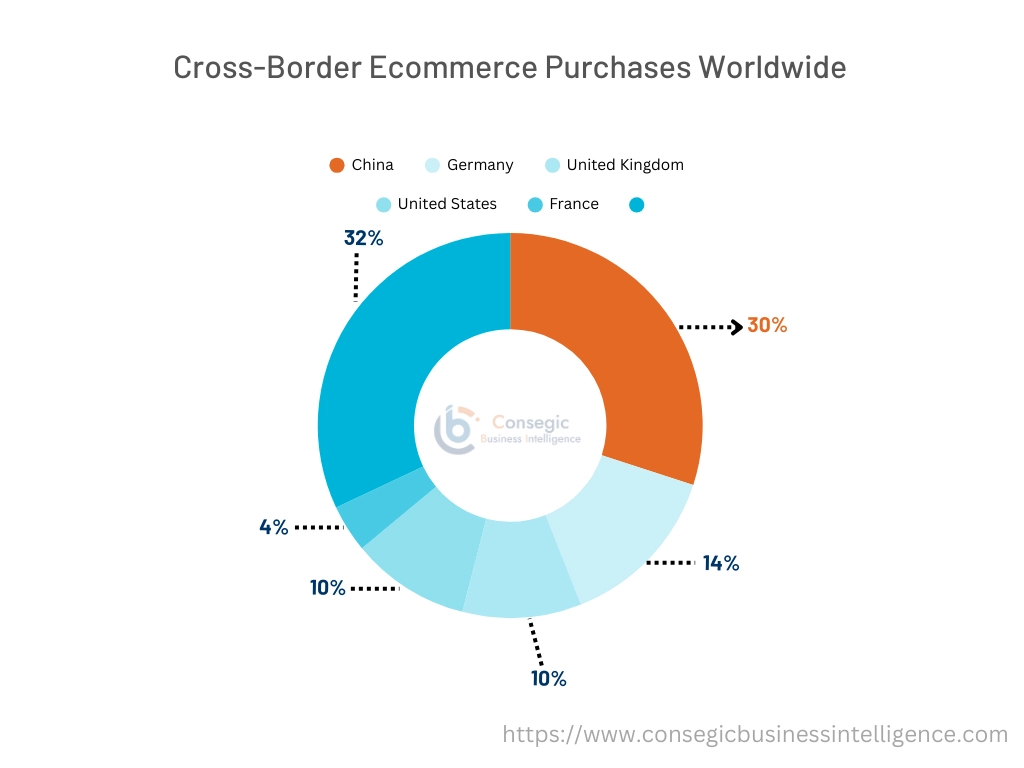
Key Restraints:
Difficulty in integrating new solutions with existing systems is restraining the global connected retail market
Many retailers rely on older systems that were not designed to interface with modern digital technologies. These systems lack the necessary APIs or data structures to seamlessly exchange information with new connected retail platforms. Additionally, retailers have data scattered across multiple disparate systems, such as point-of-sale (POS) terminal systems, inventory management software, customer relationship management (CRM) platforms, and e-commerce platforms. Integrating this data is essential for providing a personalized customer experience, but it is extremely challenging due to differences in data formats, structures, and protocols.
Further, implementing new connected retail solutions into existing systems presents a significant challenge due to its complexity which drives up implementation costs. Moreover, ongoing maintenance and support also contribute to the financial burden, further restraining the global connected retail market size. Therefore, as per the analysis, these combined factors are significantly hindering connected retail market expansion.
Future Opportunities:
AI-powered personalization is projected to create connected retail market opportunities
AI algorithms analyze vast amounts of customer data from various sources, including online browsing behavior, purchase history, social media activity, and in-store interactions. The analysis provides retailers with deep insights into individual customer preferences, needs, and buying patterns. Additionally, AI enables retailers to deliver targeted marketing campaigns and promotions that match individual customers, including personalized emails, customized in-app offers, and targeted in-store displays. Moreover, AI is expected to predict demand fluctuations and optimize inventory levels, ensuring that the right products are available at the right time, thus boosting the connected retail market demand.
- For instance, in March 2025, Resulticks launched SHOP, an AI-powered retail solution designed to unify online and offline shopping experiences. Leveraging their AI agent, Genie, SHOP analyzes real-time shopper data to create personalized, frictionless interactions, aiming to boost revenue. The solution integrates with existing systems and IoT devices, allowing retailers to target customers effectively, optimize in-store operations, and enhance customer value through tailored experiences.
Hence, based on the analysis, AI-powered personalization is expected to create connected retail market opportunities.
Connected Retail Market Segmental Analysis :
By Component:
Based on the component, the market is classified into hardware, software, and services.
Trends in the Component:
- Consulting services are also in demand to help retailers develop effective connected retail strategies.
- Growing trend towards the adoption of managed services, where third-party providers handle the ongoing management of connected retail infrastructure.
Hardware accounted for the largest revenue share of 54.43% in the market in 2024.
- Retailers are adopting IoT devices like sensors, RFID tags, and smart shelves to gather real-time data on inventory, customer behavior, and store conditions, thereby driving the connected retail market share.
- Digital signage and interactive displays are used to provide product information, personalized promotions, and engaging customer experiences, which enhance in-store communication and drive sales.
- Moreover, mobile point-of-sale (POS) systems are gaining traction, allowing retailers to process transactions anywhere in the store, which enhances customer convenience and reduces checkout times.
- For instance, in November 2024, KUBRA, in partnership with Ingenico launched an upgraded point-of-sale (POS) solution that integrates with their existing KUBRA EZ-PAY platform, bringing enhanced payment capabilities to walk-in centers. The new solution streamlines transactions by eliminating manual processes and supporting a wider range of payment methods, including credit and debit cards, EMV Chip and PIN, contactless payments, and digital wallets.
- Thus, as per the connected retail market analysis, the aforementioned factors are driving the hardware segment demand.
Software is predicted to register the fastest CAGR during the forecast period.
- Software are incorporating AI and machine learning to analyze customer data, predict behavior, and deliver personalized recommendations, driving the connected retail market share.
- Advanced analytics platforms provide retailers with actionable insights into customer preferences, inventory management and sales trends, hence driving the connected retail market size.
- Retailers are adopting software that integrates online and offline channels, providing a unified customer experience, including solutions for managing inventory, orders, and customer data.
- For instance, in Jan 2025, SymphonyAI unveiled its CINDE Connected Retail Platform, a solution leveraging predictive, generative, and autonomous AI to revolutionize retail operations. The platform provides AI-powered software suites for merchandising, store and shelf management, and supply chain optimization, offering retailers unprecedented insights and seamless connectivity.
- Consequently, the aforementioned factors are driving the software segment.
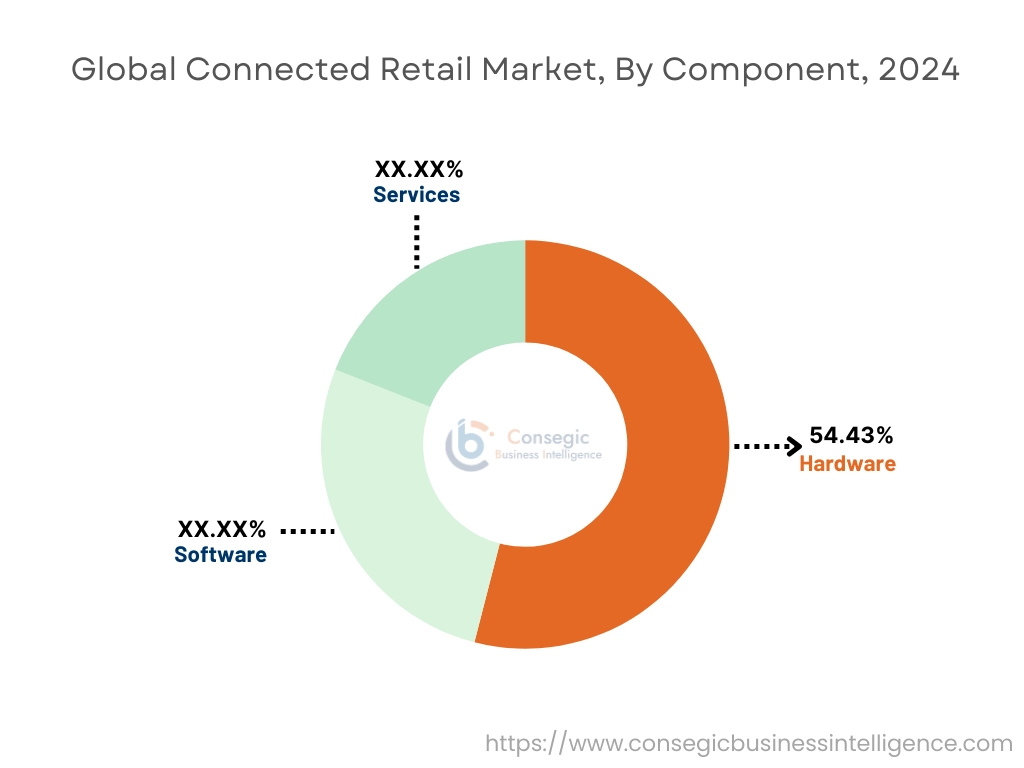
By Technology:
Based on the technology, the market is classified into ZigBee, Bluetooth Low Energy, NFC (Near Field Communication), Wi-Fi, and others.
Trends in the Technology:
- Wi-Fi's high bandwidth supports data-intensive applications like video analytics, digital displays, and real-time inventory tracking.
- Growing trend towards the adoption of ZigBee for controlling and automating in-store lighting and energy management systems is reducing costs and improving sustainability.
Bluetooth Low Energy (BLE) accounted for the largest revenue share in 2024.
- BLE is used to track customer movement within a store, allowing retailers to optimize store layouts and manage queues more efficiently, thereby driving the connected retail market trend.
- BLE enables interactive product displays that provide customers with detailed information and personalized recommendations.
- Moreover, BLE is used to create highly personalized in-store experiences, such as personalized greetings, product recommendations, and special offers.
- BLE can be used to streamline "click and collect" services, allowing customers to easily locate and retrieve their online orders.
- Thus, as per the connected retail market analysis, the aforementioned factors are driving the Bluetooth Low Energy (BLE) segment demand.
NFC (Near Field Communication) is predicted to register the fastest CAGR during the forecast period.
- NFC streamline loyalty programs by allowing customers to tap their smartphones on terminals to redeem points or access digital coupons.
- NFC can simplify the pairing of devices, such as connecting smartphones to in-store Wi-Fi or Bluetooth speakers, which enhances the customer experience by reducing friction.
- NFC can be used to instantly deliver digital receipts and product warranties to customers' smartphones, eliminating the need for paper receipts and simplifies warranty management.
- For instance, in Feb 2025, Flexa has launched a new feature allowing cryptocurrency payments via "Tap to Pay" using NFC-enabled hardware wallets, a first for the industry. This innovation enables direct blockchain transactions in physical stores without relying on smartphones or internet connectivity.
- Consequently, the aforementioned factors are driving the growth of NFC (Near Field Communication) segment.
By Application:
Based on the application, the market is categorized into apparel, electronics and appliances, food and beverage, home and personal, sporting goods and toys, and others.
Trends in Application:
- AR/VR technologies enable virtual try-ons, allowing customers to visualize clothing on themselves before purchasing.
- Growing trend towards the integration of connected appliances and electronics with smart home ecosystems, enabling seamless control and automation.
Food and Beverage accounted for the largest revenue share in 2024 and is also projected to register the fastest growth during the forecast period.
- Automated checkout systems and self-service kiosks reduce wait times and enhance customer convenience. "Grab-and-go" concepts utilize sensor technology to track items taken and automatically charge customers.
- The implementation of blockchain technology and IoT sensors facilitates end-to-end supply chain visibility, ensuring food safety and traceability. The technology enables consumers to access detailed product information through QR codes or NFC tags, driving the market size.
- AI-powered apps and platforms provide personalized meal planning and recipe recommendations based on dietary restrictions, preferences, and available ingredients, further contributing to the connected retail market growth.
- For instance, in Dec 2024, HungerRush introduced "Order Notifications," a new feature that automates personalized text updates for delivery and pickup orders, aiming to enhance customer satisfaction and streamline restaurant operations. By providing real-time order status, this feature reduces customer inquiries, allowing staff to focus on essential tasks and improving overall efficiency.
- Therefore, as per the market analysis, the aforementioned benefits are bolstering the connected retail market.
Regional Analysis:
The global connected retail market has been classified by region into North America, Europe, Asia-Pacific, MEA, and Latin America.
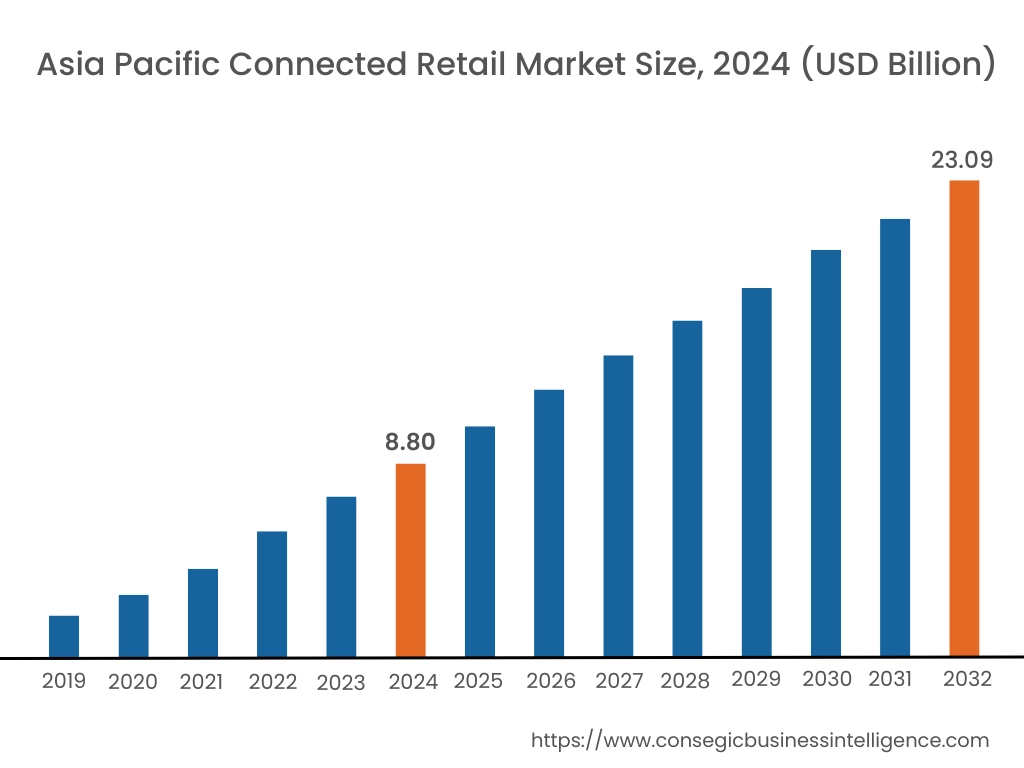
Asia Pacific region was valued at USD 8.80 Billion in 2024. Moreover, it is projected to grow by USD 9.76 Billion in 2025 and reach over USD 23.09 Billion by 2032. Out of these, China accounted for the largest revenue share of 30.82% in 2024. The region boasts a rapidly expanding base of consumers, fueled by high smartphone penetration and increasing internet access. Countries like China, India, and Southeast Asian nations are leading this trend, with consumers readily embracing mobile commerce and online shopping. Additionally, Asia-Pacific encompasses the world's largest e-commerce markets, with companies like Alibaba, JD.com, and Flipkart shaping consumer behavior. This e-commerce boom is pushing traditional retailers to adopt connected retail solutions to remain competitive.
- For instance, according to India Brand Equity Foundation, there is positive impact of e-commerce on India's economy, revealing the creation of 15.8 million jobs, with a notable 3.5 million for women. The report also indicates a surge in online spending in tier 3 cities, where consumers are spending more than those in larger urban areas.
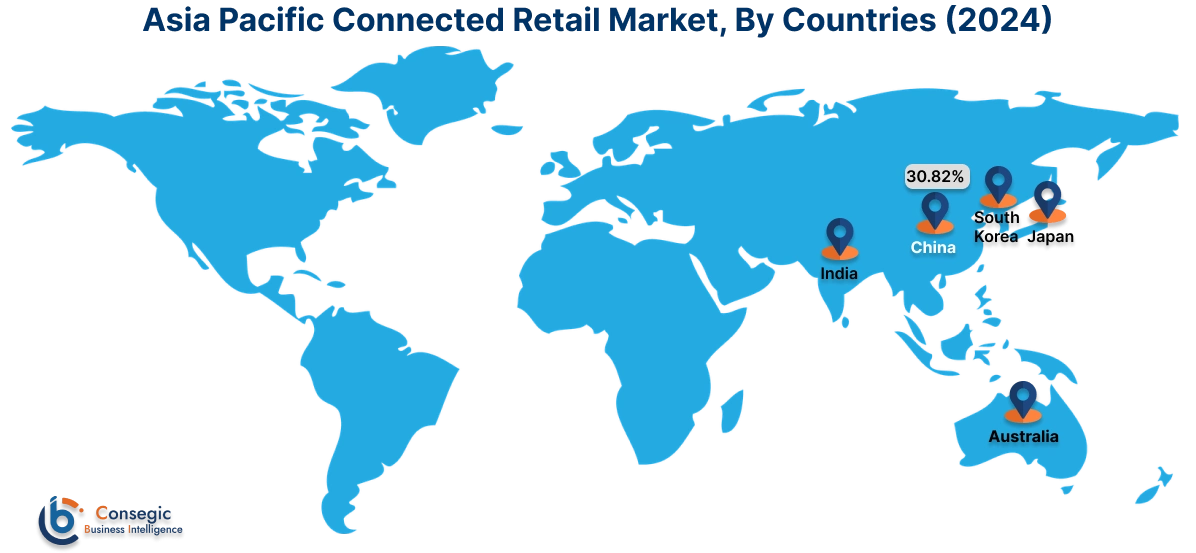
North America was valued at USD 12.56 Billion in 2024. Moreover, it is projected to grow by USD 13.90 Billion in 2025 and reach over USD 31.98 Billion by 2032.
The region is witnessing widespread adoption of omnichannel strategies, enabling customers to shop seamlessly across various platforms. Retailers are focusing on integrating online and offline experiences to provide a unified customer journey. Additionally, the presence of key players in the region are also implementing strategies to improve the connected retail market expansion.
- For instance, in April 2024, Dine Brands Global has almost completed a two-year project to upgrade 1,500 IHOP restaurants in the U.S. to the TRAY POS system. This initiative aimed to install a cloud-based point-of-sale platform that works with existing hardware, offering franchisees and operators more affordable hardware choices and flexibility. This milestone signifies a major step in modernizing IHOP's technology infrastructure.
As per the connected retail market analysis, European connected retail market is experiencing increase, driven by increasing digital literacy and a strong emphasis on personalized customer experiences. Retailers are investing in omnichannel strategies, leveraging technologies like AI and IoT to optimize operations and enhance customer engagement. Latin America's connected retail market is rapidly expanding, fueled by increasing smartphone penetration and a growing middle class. Middle East and Africa connected retail market is characterized by significant potential and rapid transformation. Rising internet and smartphone adoption, coupled with a young population, are driving the adoption of e-commerce and digital retail solutions.
Top Key Players & Market Share Insights:
The market is highly competitive with major players providing connected retail to the national and international markets. Key players are adopting several strategies in research and development (R&D), product innovation, and end-user launches to hold a strong position in the market. Key players in the connected retail industry include-
- com, Inc. (United States)
- Microsoft Corporation (United States)
- SAP SE (Germany)
- Google LLC (United States)
- Infosys Limited (India)
- Zebra Technologies Corporation (United States)
- Honeywell International Inc. (United States)
- Capgemini SE (France)
- IBM Corporation (United States)
- Intel Corporation (United States)
- Cisco Systems, Inc. (United States)
- Accenture plc (Ireland)
- Oracle Corporation (United States)
- Alibaba Group Holding Limited (China)
- Walmart Inc. (United States)
Recent Industry Developments :
Product Launches:
- In March 2025, X-hoppers launched new features for its connected store suite, aiming to enhance retail operations. By integrating hands-free headsets, AI-powered theft detection, and real-time automation, the platform seeks to reduce losses, improve team productivity, and automate essential tasks.
Business Expansions:
- In November 2022,Tesco is expanding its GetGo store trial, adding locations in London and Birmingham, including a new Chiswell Street Express. This development brings the total trial stores to three, allowing more customers to experience shopping without traditional checkouts.
Connected Retail Market Report Insights:
| Report Attributes | Report Details |
| Study Timeline | 2019-2032 |
| Market Size in 2032 | USD 89.24 Billion |
| CAGR (2025-2032) | 13.9% |
| By Component |
|
| By Technology |
|
| By Application |
|
| By Region |
|
| Key Players |
|
| North America | U.S. Canada Mexico |
| Europe | U.K. Germany France Spain Italy Russia Benelux Rest of Europe |
| APAC | China South Korea Japan India Australia ASEAN Rest of Asia-Pacific |
| Middle East and Africa | GCC Turkey South Africa Rest of MEA |
| LATAM | Brazil Argentina Chile Rest of LATAM |
| Report Coverage |
|
Key Questions Answered in the Report
How big is the connected retail market? +
The connected retail market size is estimated to reach over USD 89.24 Billion by 2032 from a value of USD 34.81 Billion in 2024 and is projected to grow by USD 38.56 Billion in 2025, growing at a CAGR of 13.9% from 2025 to 2032.
What specific segmentation details are covered in the connected retail report? +
The connected retail report includes specific segmentation details for component, technology, application, and regions.
Which is the fastest segment anticipated to impact the market growth? +
In the connected retail market, NFC is the fastest-growing segment during the forecast period.
Who are the major players in the connected retail market? +
The key participants in the connected retail market are Amazon.com, Inc. (United States), Microsoft Corporation (United States), SAP SE (Germany), Google LLC (United States), IBM Corporation (United States), Intel Corporation (United States), Cisco Systems, Inc. (United States), Accenture plc (Ireland), Oracle Corporation (United States), Walmart Inc. (United States), Infosys Limited (India), Zebra Technologies Corporation (United States), Honeywell International Inc. (United States), Capgemini SE (France), Alibaba Group Holding Limited (China), and Others.
